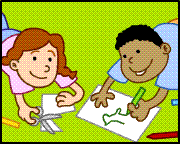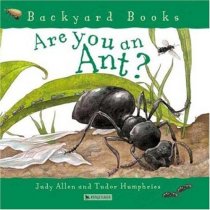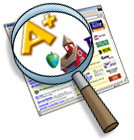|
Volume 6, Issue 10
May 12, 2008
A WORD ABOUT THIS ISSUE'S THEME
Teaching about ants? Introduce your unit with our lines of rhyme and bring on some smiles!
I saw a parade
Of ants go by.
I wonder why?
I wonder why?
One very small ant
Started to cry.
I wonder why? (Children raise hands as if questioning.)
I wonder why?
It had a big crumb
Stuck in its eye.
I wonder why? (Children raise hands as if questioning.)
I wonder why?
The ant's mother said,
"It's from that pie."
Please do not cry. (Children pretend to cry and rub eyes.)
Please do not cry.
 Soooooo… Soooooo…
Children remember
At picnics with pie,
Crumbs go in your mouth… (Children point to mouths.)
Not in your eye!
Susan LaBella
Editor, Early Childhood Education Newsletter
ACTIVITY IDEAS

SENTENCE SENSE
Read to children Are You An Ant? by Judy Allen. Discuss some facts about ants that children learned. Next, prepare word cards that when correctly ordered create a factual sentence about ants. (Example: An ant has six legs.) Mix up the cards and let children assemble them to create a sentence.
HUNGRY ANTS
Use a marker to divide a paper plate into six sections. Place different food scraps in each section such as apple pieces, cookie crumbs, bread bits, peanut butter, leaves, and so on. Place the plate in an area where you have seen ants in the past or near an anthill you have found. (Try to keep safe from birds.) Let children observe each day and record what they see. Which food have ants eaten fastest? Make a simple graph to show the results.
ANTS IN THE SAND
Try this simple snack with your class. Crush graham crackers and place in a zip lock bag. Add raisins and mix well. Give a small bag to each child and let him/her enjoy the "ants in the sand." In place of raisins you may wish to use bits of other dried fruit, mini chocolate bits, or bits of red string licorice for "fire ants."
LET'S COMPARE
After sharing books about ants, discuss their characteristics. Next review characteristics of other animals. How are ants and other animals alike? How are they different? Create a large Venn diagram. Label the circle on the left "Ants." Label the circle on the right "Other Animals." Label the area at the intersection of the two circles "Both." Invite children to contribute facts they learned. Record facts in the correct section of the diagram and review with children. Follow up by having children choose an ant fact to illustrate. Example "An ant has three body parts."
WHERE ARE THE ANTS?
Let children create a picture of an anthill, an ant tunnel, or even a picnic scene. Next prepare "ants" for children's pictures. Mix 1 cup uncooked rice with one-half teaspoon of rubbing alcohol and a few drops of black or dark food coloring. Spread rice on a flat pan to dry (up to a day). Give each child a small amount of rice and help children glue the "ants" onto pictures in appropriate places.
ON THE WEB
All About Ants
You'll find great background information about ants here, plus some suggestions for books about ants.
 http://www.infowest.com/life/aants.htm http://www.infowest.com/life/aants.htm
Ants of the World
See some wonderful photos of all kinds of ants.
http://www.livescience.com/php/multimedia/imagegallery/igviewer.php?imgi...
Children's Literature Across the Curriculum Ideas
After reading Two Bad Ants by Chris Van Allsburg, try some of these curriculum connections.
http://library.uncc.edu/files/5/cimc/pdfs/units/twobadants.pdf
Ant Farms
If you're thinking about an ant farm for your classroom, check out this site first. Some great and helpful information is here.
http://www.antfarms.net/maintenance.html
All About Ants
A lesson on ants that integrates art, math, and technology.
https://teachers.net/lessons/posts/3253.html
|